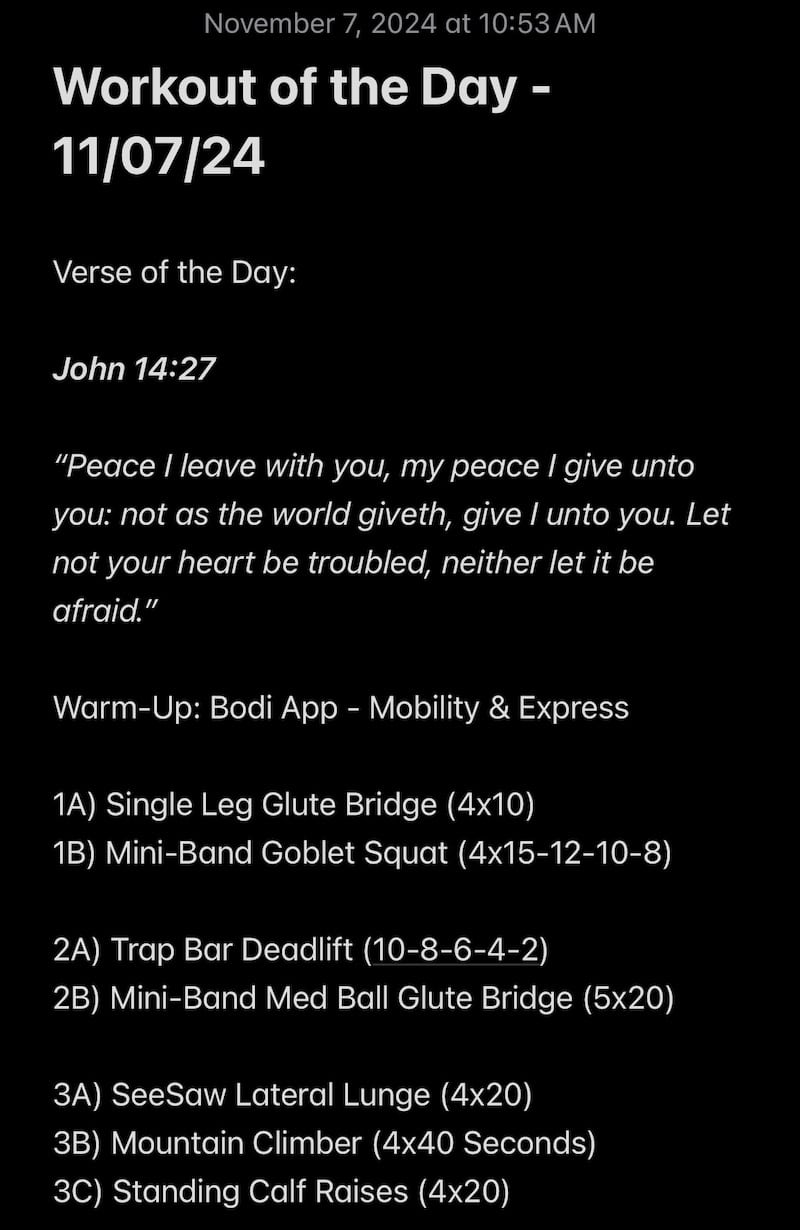11/07/2024 – Workout of the Day (Posterior Chain & Core)
Hello, I’m Adam Kemp, and today’s workout is a strength training session designed to develop the posterior chain and core. Strengthening the posterior chain—comprising the glutes, hamstrings, lower back, and supporting core muscles—improves overall stability, balance, and functional movement.
By targeting these areas, this session supports a stronger foundation for lifting, running, jumping, and daily activities that require coordinated muscle engagement.
Inspired by John 14:27, this workout also brings an element of mindfulness, reminding us to cultivate peace within as we build strength.
Each of these posterior chain exercises has been selected to activate key muscles while challenging core stability, creating a balanced routine that supports both physical and mental resilience.
This workout alternates between single-leg exercises, compound lifts, and core movements, maximizing muscle activation in the lower body while encouraging precise, controlled movements that protect the spine and joints.
With a combination of dynamic and isometric exercises, this routine is ideal for improving power, endurance, and form, making it suitable for athletes and fitness enthusiasts looking to enhance their posterior chain strength and stability.
Quick Workout Summary
Warm-Up
Organized into supersets, this routine moves through strength-focused and stability-enhancing exercises for a complete lower body and core challenge.
The workout flows from glute activation and leg strength to more dynamic, stability-demanding movements, incorporating compound lifts and functional movements that develop overall balance.
- Superset 1:
- 1A: Single Leg Glute Bridge (4×10)
- 1B: Mini-Band Goblet Squat (4×15-12-10-8)
- Superset 2:
- 2A: Trap Bar Deadlift (5 sets: 10, 8, 6, 4, 2)
- 2B: Mini-Band Med Ball Glute Bridge (5×20)
- Superset 3:
- 3A: SeeSaw Lateral Lunge (4×20)
- 3B: Mountain Climber (4×40 seconds)
- 3C: Standing Calf Raises (4×20)
Workout of the Day (11/07/2024)
Warm-Up: Mobility & Express (BoDi App)
This mobility warm-up prepares the body for dynamic movement by focusing on flexibility and joint range, reducing the chance of injury while promoting fluidity in each exercise.
Superset 1
1A) Single Leg Glute Bridge
Sets & Reps: 4 sets (10 reps per side)
This unilateral glute exercise strengthens the hamstrings and glutes while engaging the core for stability. The single-leg format challenges balance, improving hip stability and building a strong foundation for leg-dominant movements.
- Progression: Add weight or elevate the foot on a bench.
- Regression: Perform a standard glute bridge with both feet on the ground.
1B) Mini-Band Goblet Squat
Sets & Reps: 4 sets (15, 12, 10, 8)
The mini-band goblet squat engages the glutes, quads, and core, adding resistance with the mini-band to promote knee stability and hip engagement. This variation on the squat improves lower body strength and mobility and is one of the best exercises for weight loss.
- Progression: Use a heavier weight or increase band tension.
- Regression: Perform a regular goblet squat without a mini-band or reduce weight.
Superset 2
2A) Trap Bar Deadlift
Sets & Reps: 5 sets (10, 8, 6, 4, 2)
A compound movement that targets the glutes, hamstrings, quads, and core, the trap bar deadlift builds functional strength through the posterior chain. This lift promotes power and stability, essential for athletic performance and daily activities.
- Progression: Increase the weight each set or add a brief hold at the top.
- Regression: Use a lighter weight or perform traditional deadlifts with a barbell.
2B) Mini-Band Med Ball Glute Bridge
Sets & Reps: 5 sets (20 reps)
Adding a mini-band to the glute bridge activates the hip abductors, targeting the glutes while promoting knee and hip stability. This high-repetition movement builds endurance in the glutes and hamstrings, complementing the strength focus of the deadlift.
- Progression: Place feet on an elevated surface or add weight.
- Regression: Remove the mini-band and perform standard glute bridges.
Superset 3
3A) SeeSaw Lateral Lunge
Sets & Reps: 4 sets (20 reps alternating)
This dynamic lateral lunge variation targets the inner thighs, glutes, and quads while enhancing hip mobility and balance. The see-saw motion challenges stability, improving coordination and control in lateral movements.
- Progression: Add dumbbells or increase range of motion.
- Regression: Perform a stationary lateral lunge, reducing depth if needed.
3B) Mountain Climber
Sets & Duration: 4 sets (40 seconds each)
A core-centric endurance move, mountain climbers are one of the best alternatives to crunches for building core strength, as they engage the abs, shoulders, and legs while boosting cardiovascular endurance and core stability. This fast-paced motion not only supports overall coordination and agility but also offers an effective path for those wondering how to get six-pack abs through functional, high-intensity movement.
- Progression: Increase speed or extend the time.
- Regression: Slow down the movement, focusing on controlled knee drives.
3C) Standing Calf Raises
Sets & Reps: 4 sets (20 reps)
Calf raises strengthen the lower legs, improving balance, stability, and ankle mobility. They support stronger, more powerful lower body movements, helping prevent injury and enhancing endurance.
- Progression: Add weight or perform single-leg calf raises.
- Regression: Reduce the reps and focus on form.
Tips for Success
- Seek Steady Progress: With each exercise, embrace a calm, controlled pace, channeling peace and focus into every rep as you move towards strength gains.
- Stay Centered on Form: Emphasize proper technique, especially during compound lifts like the deadlift and lateral lunge, to ensure balanced muscle activation and prevent strain.
- Breathe Deeply: Use intentional breathing to maintain stability and rhythm, especially in core-focused moves like mountain climbers.
- Listen to Your Body: Adapt progressions and regressions as needed, ensuring that each movement aligns with your strength level and goals.
By anchoring this workout in peaceful intention and mindful control, you’ll cultivate both physical resilience and a calm, focused mindset, supporting a stronger, more centered approach to training and life.



